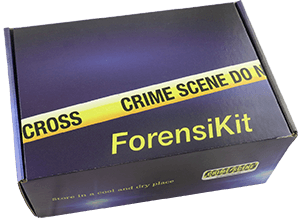|
MISSISSIPPI CRIME LABORATORY |
|||
|
REPORT DATE: 6/27/2024 Andrew Needham, FTEE |
Analysis: Trace Evidence Examination |
||
|
Case #: 003016-16F-2024 |
Case Description: Monica Drum Homicide |
||
|
Investigative Agency: Yoknapatawpha County Sheriff's Department |
Investigating Officer(s): Det. S. Murphy, Det. E. Parker |
||
Preliminary Analysis of Evidence Recovered from the Ledford Property, New Sarpy, LA
Fibers
Fiber samples were collected from the dark green collared knit shirt taken into evidence from Rick Hughes's residence, the hunter green work shirt taken into evidence from David Ledford's residence, and the hunter green work shirt taken into evidence from David Ledford's fishing camp.
Those samples were compared to the fibers recovered from the crime scene, and the fibers from Ledford's work shirts were found to be microscopically similar (both were 65% Fortrel polyester/35% cotton). Thin layer chromatography (normal phase silica, 5% methanol/chloroform) of the fiber dyes of each sample also gave similar chromatograms:
A final basis of comparison was infrared spectrometry of the fibers, which also suggested that the two samples from Ledford's work shirts are similar to fibers from the crime scene.
Conclusion: The fibers of the shirts of David Ledford can be included as a possible match to the fibers collected at the crime scene. The fibers of the shirt of Rick Hughes are excluded as a possible match to the fibers collected at the crime scene.
Pollen and Animal Hairs

Soil samples collected from the property where Rick Hughes's residence is located, the property where David Ledford's residence is located, and the property where David Ledford's fishing camp is located were compared to samples from the crime scene.
Soil samples taken around the Ledford property had similar mineralogy and contained the same type of pollen grains in the crime scene sample. Visual inspection of the Ledford property by palynologist Dr. Melvin McCoy also confirmed the presence of bald cypress trees, palmettos and water oaks. Dr. McCoy also noted that microscopically the extent and ratio of each pollen type of the crime scene sample was similar to samples taken from the Ledford property.
During the search, investigators noted the presence of several animal hides, two of which were subsequently taken to the crime lab for examination. The hair from one of these hides was shown microscopically to originate from a swamp rabbit. The hair of the second hide was identified as the gray squirrel.
Conclusion: The soil and animal hairs found on the Ledford property are generally consistent with the samples found at the crime scene. The soil collected from the Hughes property was not consistent with samples found at the crime scene.
Fingerprints
|
Comparison of unidentified fingerprints recovered at the crime scene found Fingerprint 003016-P032 from the computer monitor is consistent with David Ledford's right thumbprint. |
|
|
Other findings
Shoes collected in the Hughes and Ledford searches were compared with the footwear impressions found at the crime scene. The workboots recovered from David Ledford's residence and fishing camp are generally consistent in size and shape with the footprints at the crime scene.
The .38 Smith & Wesson revolver handgun collected from David Ledford's fishing camp is consistent in caliber and manufacturer with the murder weapon. Firearms analysis is ongoing.



